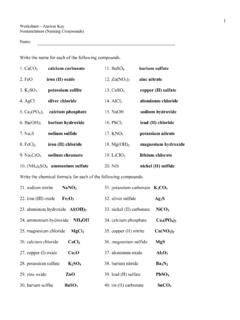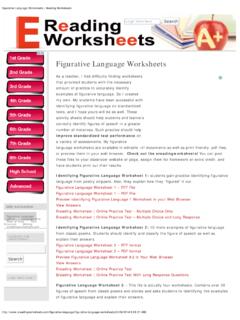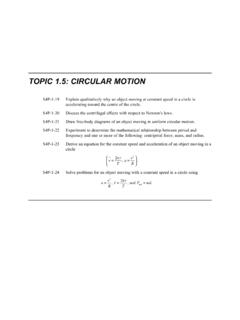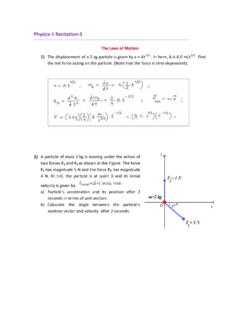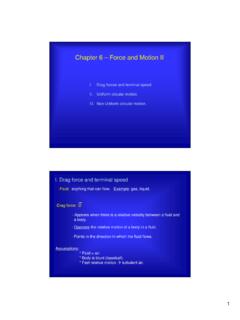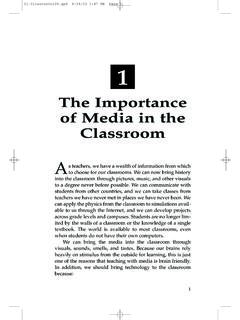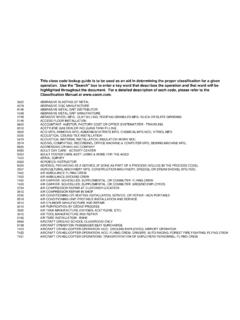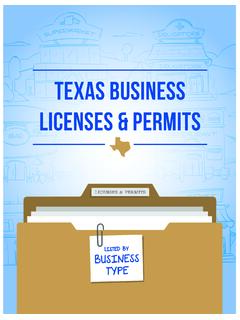Transcription of AUTHOR’S PURPOSE & PERSPECTIVE
1 CATAGORY 2: READING APPLICATION. A STUDY GUIDE FOR: AUTHOR'S PURPOSE &. PERSPECTIVE . OBJECTIVE: The student will analyze the author's PURPOSE and/or PERSPECTIVE in a variety of text and understand how they affect meaning. FOR SCHOOL YEAR 2011 2012. INTENSIVE READING. 2. Category 2: Author PURPOSE and PERSPECTIVE What is it? Questions to Expect The AUTHOR'S PURPOSE is the reason that the author chose to write What is the author's PERSPECTIVE in the passage. When discussing this article? (author's point of view). author's PURPOSE we usually use What does the author use to get her verbs such as persuade, entertain, point across? (author's point of view). or inform, or some combination of these. In the author's opinion, what should be done to: _____? (author's The AUTHORS PERSECTIVE is how PERSPECTIVE ). an author feels about the topic he or What does the _____.
2 She is writing about. represent in this selection? (author's PERSPECTIVE ). Why does the speaker in the poem _____? (author's PURPOSE ). Why Is It Important? What is the author's PURPOSE in this If you know how to figure out article? (author's PURPOSE ). author's PURPOSE you will be able to: With which statement listed below Recognize bias and decide would the author of this article most whether a source of likely agree? (author's PERSPECTIVE ). information can be trusted. Which statement BEST describes the author's attitude toward Understand why an author _____? (author's PERSPECTIVE ). says things in a specific way or includes some facts and not others. Sample Questions for Different Genres: Poetry: The author wants the reader to think _____. (The multiple-choice answers will offer possible endings to this sentence.). Fiction: Which statement best describes what the author probably thinks about drinking and driving?
3 Non-Fiction: What is the author's PURPOSE for saying, I never thought it could happen to me either? . 3. Identify Author's PURPOSE : Why Did the Author Write the Selection? Why do you think the author wrote the article? To persuade? To entertain? To inform? To express? Author's PURPOSE is the reason or reasons an author has for writing a selection. If readers enjoyed what they read, one of the author's purposes may have been to entertain. If students learn while they are reading, one of the author's purposes may have been to inform. If readers changed the way they thought about a topic or issue, one of the author's purposes may have been to persuade. Authors may have more than one PURPOSE for writing. Author's PURPOSE can be stated explicitly or readers may have to infer the intent. Reflective readers are able to analyze information more thoughtfully when they know an author's PURPOSE .
4 Identifying an author's PURPOSE may give you clues for pacing your reading. Readers need to adjust their reading rate for various selections. For example, informational articles may require you to slow down in order to fully understand ideas described. Reading Strategy: Questions that help students explore author's PURPOSE : 1. Based on the title, why do think the author wrote this selection? 2. Which words do you think best describe the main reason the author wrote this selection: to provide readers with information? To describe a person, event, or issue? To express their own thoughts and feelings? To persuade readers to think about an issue in a certain way and to take action? Or to entertain the reader? 3. Why did the author write the article from a particular PERSPECTIVE ? 4. How did the author influence your response to the selection? 5. Was the author's PURPOSE specifically stated?
5 6. Do you think that the author achieved his/her intended purposes? Did the article effectively give information? Entertain readers? Express the author's thoughts and feelings? Persuade readers to think about an issue and/or take action? 7. What examples from the text support your conclusions about author's PURPOSE ? 4. Identify Author's PERSPECTIVE : What Does the Author Think? Author's PERSPECTIVE is the way an author looks at a topic or the ideas being described. The author's PERSPECTIVE includes the content of the text and the language used to present the data. Thoughtful readers are able to discern an author's PERSPECTIVE , opinions, hypotheses, assumptions, and possible bias. Understanding the author's PERSPECTIVE helps you read analytically in order to identify the validity of information contained in the text. Try to identify words and phrases that show an author's strong feelings for or against a person, group, or issue.
6 Reading Strategy: Questions that help students explore author's PERSPECTIVE : 1. What opinions or belief statements are evident in the article? 2. Why do you think the author has this particular opinion or point of view? 3. What background information about the author does the reader have that may help understand the writer's PERSPECTIVE ? Would another author have a different PERSPECTIVE depending on his/her background experiences? 4. What pictures does the author paint for a reader? 5. What evidence did the author include to support his or her opinions? 6. What facts were missing? 7. What words and phrases did the author use to present the information? 8. Did the words the author chose have a strong connotation? 9. Why did the author write this selection? Identifying the author's PURPOSE helps you recognize possible perspectives, especially in persuasive writing.
7 5. Reading Strategy: Persuade, Inform, Entertain, Share an experience or feeling Identify the author's PURPOSE and support it by returning to the text for details and information. Tips for Answering Author's PURPOSE and PERSPECTIVE Questions Questions about the author's PURPOSE ask you to determine why an author wrote a particular passage. For example, an author might write a passage in order to persuade an audience, describe something, explain a process, define a term, refute a claim, analyze a text, or convey personal feelings. Understanding the author's tone his or her attitude toward the subject and audience will help you understand the PURPOSE and the author's PERSPECTIVE . Authors convey PURPOSE and PERSPECTIVE through their choice of words and the impression those words create. Author's PURPOSE questions will usually include one of the following key words: author's PURPOSE , reason, why, the passage can best be described as.
8 You may also be asked to identify the tone of the passage or the PERSPECTIVE of the author based on his or her words. Author's PURPOSE answer options often incorporate the following vocabulary words: analyze, compare, contrast, critique, evaluate, examine, investigate, characterize, define, depict, describe, explain, identify, introduce, narrate, recount, summarize, acknowledge, advocate, assert, promote, propose, support, condemn, criticize, oppose. Familiarize yourself with the subtle distinctions in meaning among these various words. For instance, to describe is to trace out or give a pictorial account of, to explain is to make clear or to give a reason for, and to analyze is to examine in detail. 6. Strategies for Answering Author's PURPOSE Questions: Look for key words that identify the question as an author's PURPOSE question. If the question includes any of the author's PURPOSE key words listed above, make a note that you are looking for the author's PURPOSE .
9 The reason the author wrote the passage. This will help you focus on the author's tone as you read, which in turn will help you identify his or her PURPOSE . Read the passage and make notes. Once you've identified the question as an author's PURPOSE question, read the passage, making note as you read. Consider the words an author chooses to use. Word choice is one way authors convey their meaning when they expect the reader to infer that meaning. Consider the vocabulary of your answer options. Is the author really analyzing something, or is she describing it? Use your knowledge of key vocabulary words to eliminate wrong answers and identify the better answer. Reading Strategy: Switching: An Author's PURPOSE /Point of View Strategy Switching (McLaughlin & DeVoogd, 2004) is a strategy that can help show biases in the text as well as make the reader more aware of the author's intention.
10 Some of the switches are: 1. Gender switch--Change the sex of the main characters. 2. Theme switch--Make up a different story with the opposite theme: example 'peace is good' to 'force is good'. 3. Setting switch--Tell the story form a different time, place, or social class. 4. Body-Style switch--Change main character body: fat to thin or tall to short 5. Clothing switch--Change main character clothing: preppy, gang, formal, hip-hop. 6. Emotion switch--Imagine a story in which the characters have a different emotional tone: calm and thoughtful or cracking jokes all the time. 7. Ethnic/Race switch--Change characters' race/ethnic characteristics. 7. 8. Language switch--Use accents, vocabulary, and expressions from somewhere different, such as another country, a university, or a region of the country. 9. Relationship/Organization switch--if the main characters are friends, change to family members, enemies, etc.
